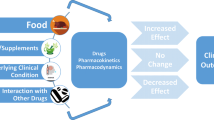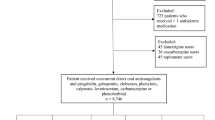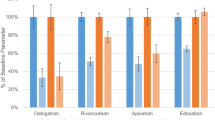Abstract
Purpose
It is established that omeprazole increases (R)+ warfarin levels with around 10 %. Whether (es)omeprazole also increase the plasma levels of acenocoumarol or phenprocoumon is still uncertain. We analyzed whether addition of (es)omeprazole to acenocoumarol or phenprocoumon increases the international normalized ratio (INR) levels and the risk of overanticoagulation.
Methods
We analyzed all hospital admissions in four teaching hospitals. Patients who used coumarins and pantoprazole or (es)omeprazole simultaneously for at least four consecutive days were included in the study. We analyzed the highest INR level and whether patients had an INR level above six. We compared patients using omeprazole or esomeprazole with patients using pantoprazole, because for pantoprazole, no interaction has been reported.
Results
We analyzed 5747 admissions with 4540 patients using one of the drug combinations. For acenocoumarol (4578 admissions), no significant differences were found between users of esomeprazole, omeprazole, and pantoprazole. For phenprocoumon (1169 admissions), the highest INR measured was significantly higher in users of esomeprazole than in users of pantoprazole (4.7 versus 4.3; p = 0.035). No significant difference was found with omeprazole versus pantoprazole (4.3 versus 4.3; p = 0.66). A non-significant association was found between the esomeprazole dose and the highest INR level (p = 0.055). The risk of an INR above six did not differ significantly between esomeprazole and pantoprazole (27.7 % versus 22.9 %; p = 0.34).
Conclusions
The use of esomeprazole simultaneously with phenprocoumon during hospital admissions might increase the anticoagulant effect. The clinical relevance seems to be limited, because no statistically significant increased risk of overanticoagulation was found.

Similar content being viewed by others
References
Cannegieter SC, Rosendaal FR, Wintzen AR, van der Meer FJ, Vandenbroucke JP, Briët E (1995) Optimal oral anticoagulant therapy in patients with mechanical heart valves. N Engl J Med 333:11–7. doi:10.1056/NEJM199507063330103
Visser LE, Penning-van Bees FJ, Kasbergen AA, De Smet PA, Vulto AG, Hofman A, Stricker BH (2002) Overanticoagulation associated with combined use of antibacterial drugs and acenocoumarol or phenprocoumon anticoagulants. Thromb Haemost 88:705–10. doi:10.1267/th02110705
Baxter K (2008) Stockley’s drug interactions, 8th edn. Pharmaceutical Press, London
Teichert M, van Noord C, Uitterlinden AG, Hofman A, Buhre PN, De Smet PA, Straus S, Stricker BH, Visser LE (2011) Proton pump inhibitors and the risk of overanticoagulation during acenocoumarol maintenance treatment. Br J Haematol 153:379–85. doi:10.1111/j.1365-2141.2011.08633.x
Verhoef TI, Zuurhout MJ, van Schie RM, Redekop WK, van der Meer FJ, le Cessie S, Schalekamp T, de Boer A, Maitland-van der Zee AH (2012) The effect of omeprazole and esomeprazole on the maintenance dose of phenprocoumon. Br J Clin Pharmacol 74:1068–9. doi:10.1111/j.1365-2125.2012.04295.x
de Hoon JN, Thijssen HH, Beysens AJ, Van Bortel LM (1997) No effect of short-term omeprazole intake on acenocoumarol pharmacokinetics and pharmacodynamics. Br J Clin Pharmacol 44:399–401. doi:10.1046/j.1365-2125.1997.00600.x
Federation of Dutch Thrombosis Services (2015) Management of coumarin interactions (in Dutch: Afhandeling cumarine-interacties). www.fnt.nl. Accessed 11 January 2015.
Ufer M (2005) Comparative pharmacokinetics of vitamin K antagonists. Clin Pharmacokinet 44:1227–46. doi:10.2165/00003088-200544120-00003
Enderle C, Müller W, Grass U (2001) Drug interaction: omeprazole and phenprocoumon. BMC Gastroenterol 1:2. doi:10.1186/1471-230X-1-2
Brunner-Ziegler S, Jilma B, Magirr D, Sunder-Plassmann R, Giurgea GA, Hammer A, Margeta C, Brunner M, Koppensteiner R, Mannhalter C (2014) Influence of proton pump inhibitors and VKORC1 mutations on CYP2C9-mediated dose requirements of vitamin K antagonist therapy: a pilot study. Br J Haematol 167:547–53. doi:10.1111/bjh.13082
Schmidt W, Jähnchen E (1977) Stereoselective drug distribution and anticoagulant potency of the enantiomers of phenprocoumon in rats. J Pharm Pharmacol 29:266–71. doi:10.1111/j.2042-7158.1977.tb11309.x
Godbillon J, Richard J, Gerardin A, Meinertz T, Kasper W, Jähnchen E (1981) Pharmacokinetics of the enantiomers of acenocoumarol in man. Br J Clin Pharmacol 12:621–629. doi:10.1111/j.1365-2125.1981.tb01280.x
Compliance with ethical standards
The authors declare that they have no conflict of interest.
For this type of study, formal consent is not required.
Author information
Authors and Affiliations
Corresponding author
Rights and permissions
About this article
Cite this article
Becker, M.L., Franken, W.P.J., Karapinar, F. et al. Possible drug-drug interaction between high-dose esomeprazole and phenprocoumon. Eur J Clin Pharmacol 71, 1461–1465 (2015). https://doi.org/10.1007/s00228-015-1912-1
Received:
Accepted:
Published:
Issue Date:
DOI: https://doi.org/10.1007/s00228-015-1912-1




